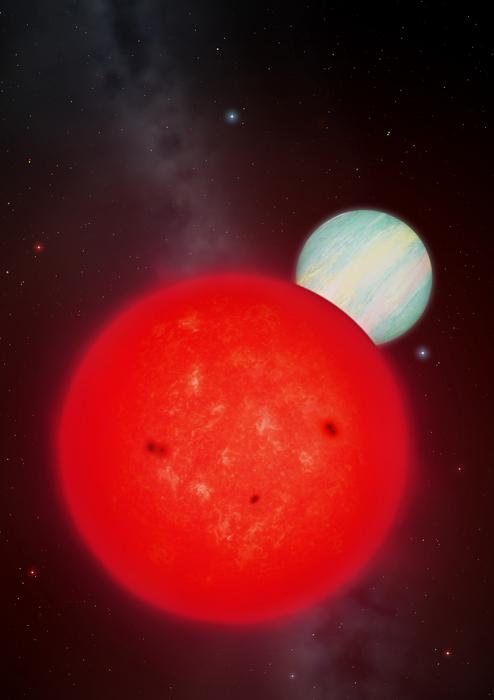In a groundbreaking revelation poised to upend established astronomical theories, a team of international researchers has unveiled the existence of a giant exoplanet orbiting an exceptionally low-mass red dwarf star, designated TOI-6894. This discovery challenges the long-held assumption that stars possessing merely a fraction of the Sun’s mass are incapable of nurturing such massive planetary companions, offering a startling glimpse into the complexities of planetary formation in the cosmos.
TOI-6894 is a diminutive red dwarf star, possessing approximately 20% of the Sun’s mass, arguably one of the most common stellar types scattered throughout our galaxy. Conventionally, stars of this size are considered unlikely hosts to gas giants because their protoplanetary disks—the circumstellar cocoons of gas and dust where planets emerge—are thought to lack sufficient material to form massive cores necessary to gravitationally attract vast gaseous envelopes. Yet, contravening this expectation, TOI-6894b, a newly identified gas giant, orbits its modest host, signaling a significant anomaly in our understanding of planet formation.
This monumental discovery surfaced from a comprehensive survey leveraging data from the Transiting Exoplanet Survey Satellite (TESS), a space-based observatory designed to detect planets crossing in front of their stars. Dr. Edward Bryant, leading the investigation from The University of Warwick and UCL’s Mullard Space Science Laboratory, meticulously sifted through over 91,000 low-mass stellar observations. His analysis culminated in the confirmation of TOI-6894b—a gas giant notable not only for its size but also for being the smallest star to date known to harbor such a planetary behemoth.
Characterized by an intriguing combination of substantial radius and surprisingly low mass, TOI-6894b possesses a size slightly exceeding that of Saturn. However, its mass is approximately half that of Saturn’s, rendering it remarkably low-density for a gas giant. This physical composition piques scientific curiosity, intimating that the processes that forged TOI-6894b might diverge fundamentally from conventional planetary formation paradigms observed in larger, more massive stellar environments.
Historically, the core accretion model has dominated the narrative of gas giant formation. According to this model, a solid planetary core incrementally grows by gathering material within the protoplanetary disk until it reaches a threshold mass. Once this apex is surpassed, the core triggers a runaway accretion phase, rapidly engulfing surrounding gas to form a massive atmosphere, thus becoming a gas giant. However, around low-mass stars like TOI-6894, the relative scarcity of available material inhibits the formation of sufficiently massive cores, ostensibly precluding the birth of large gas planets.
Given the presence of TOI-6894b, researchers posit that alternative or supplementary mechanisms might sculpt planetary systems in low-mass environments. Dr. Bryant suggests that TOI-6894b could have emerged through a modified core accretion pathway, wherein the planet steadily accrues gas without the runaway phase, or perhaps more intriguingly, from a gravitational instability mechanism. In this latter scenario, the protoplanetary disk itself becomes gravitationally fragmented, with clumps rapidly collapsing to form planetary-mass objects, bypassing the gradual core-centric buildup altogether.
Despite these propositions, neither the traditional core accretion theory nor the gravitational instability model fully accounts for the unique characteristics and formation pathway of TOI-6894b. This ambiguity underscores a tantalizing mystery: the genesis of certain gas giants around the smallest stars may elude current theoretical frameworks, necessitating innovative hypotheses and further observational evidence to reconcile such anomalies.
To unravel the enigma surrounding TOI-6894b’s origins, scientists are turning their attention to the planet’s atmosphere, a promising archive of chemical signatures and structural information. Detailed spectroscopic studies of the atmospheric composition can reveal the presence and ratios of elements and molecules, elucidating the planet’s core size and formation history. This atmospheric “fingerprint” serves as a cosmic laboratory, potentially differentiating whether TOI-6894b owes its existence to steady accretion or rapid disk fragmentation.
Notably, TOI-6894b exhibits markedly cooler temperatures than the majority of detected gas giants, which typically manifest as “hot Jupiters” with scorching atmospheres ranging between 1000 and 2000 Kelvin. Measuring a comparatively frigid 420 Kelvin, this planet stands as one of the most amenable targets for atmospheric characterization among cool giants. Its cool environment favors complex methane chemistry, a rarity among exoplanets studied so far, and may even reveal ammonia signatures—the first time such compounds might be identified beyond our own Solar System.
Experts like Professor Amaury Triaud of the University of Birmingham emphasize the exceptional nature of TOI-6894b’s atmosphere as a benchmark for studying methane-dominated chemistry. This characteristic renders the planet an unparalleled “laboratory” for examining planetary atmospheres rich in carbon, nitrogen, and oxygen, offering fresh insights into the diversity of exoplanetary atmospheres and their underlying chemical pathways.
The upcoming observational campaign utilizing the James Webb Space Telescope (JWST) is poised to play a pivotal role in demystifying TOI-6894b’s atmospheric composition. Equipped with advanced infrared capabilities, JWST is expected to dissect the molecular constituents of the planet’s atmosphere within the next twelve months, constraining theoretical models and refining our understanding of planetary genesis around low-mass stars.
Co-author Dr. Andrés Jordán from the Millennium Institute of Astrophysics highlights the strategic importance of TOI-6894b as a target for follow-up analysis. The cumulative findings not only confront prevailing beliefs about giant planet formation but also enrich the catalog of celestial bodies essential for comparative planetary science. The systematic observational program spearheaded from Chile and the UK exemplifies the collaboration necessary to uncover such rare and intriguing planetary systems.
In conclusion, the discovery of TOI-6894b compellingly illustrates that nature often defies simplified categorization. By demonstrating that substantial gaseous planets can indeed manifest around minuscule stars, this finding propels the astrophysical community toward reexamining planetary formation theories. The planet’s low density, cool temperature, and enigmatic origin collectively present a compelling frontier for future research, inviting astronomers worldwide to explore the unknown boundaries of exoplanetary science.
Subject of Research: Not applicable
Article Title: A transiting giant planet in orbit around a 0.2-solar-mass host star
News Publication Date: 4-Jun-2025
Web References:
https://www.nature.com/articles/s41550-025-02552-4
https://science.nasa.gov/mission/webb/
https://www.speculoos.uliege.be/cms/c_4259452/en/speculoos
References:
DOI: 10.1038/s41550-025-02552-4
Image Credits: University of Warwick/Mark Garlick
Keywords: Exoplanets, Planets, Atmospheric science, Astronomy, Gas giants




